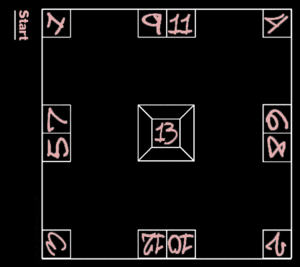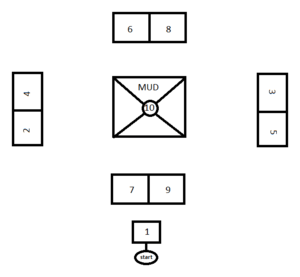Skully (game) facts for kids
Skelly, also known as Skully, is a fun street game played by children, especially in cities like New York City. Players draw a special board on the ground, usually with chalk, and use bottle caps to play. It's a game for two to six players and can be finished in about 20 minutes with a few players.
The rules for Skelly can change a lot from one neighborhood to another. Before starting a game, players usually agree on the rules, especially if they are from different areas. This makes sure everyone knows how to play fairly.
Contents
The Skelly Board
The Skelly board is a large square drawn on a flat surface, like a street or playground pavement. It's usually about six feet (2 meters) wide.
Around the edges and at the corners of this big square, there are 12 smaller squares called boxes. Each box is about six inches (15 cm) wide. These boxes are numbered from "1" to "12". The numbers are placed so that to move from one box to the next, you often have to go through the large center square. This center square is called the skull or skully, which is where the game gets its name!
In the middle of the skull area, there's a 13th box, also about six inches wide, labeled "13". The areas around box 13 are sometimes marked with skulls or numbers. This is a special penalty area where players try not to land their game pieces.
A short line, called the start line, is drawn a little way from box "1". This is where players begin.
Board Variations
The size and design of the Skelly board can be different depending on the space available or how people play in certain neighborhoods. Some older versions of the board had only 9 boxes. Other similar games, like deadbox played in Philadelphia, might have more than 15 boxes.
In some game layouts, the central area is called "MUD". If your bottle cap lands in the "MUD", you might lose 3 turns. One version of the game board, used in New Rochelle, NY around 1963, had the game go up to 10. The number 10 was in a small circle in the middle of the "MUD" area. This board also had a "start" oval below the main area instead of numbered corner squares.
How to Play Skelly
Players use caps to play. These are usually bottle caps, but sometimes players use checkers or other small, flat items. Many players make their caps heavier so they glide better. They might fill them with clay, wax, melted crayons, or even tar found on the streets. Players often take pride in making their caps unique.
To start, each player places their cap on the start line. Players flick their cap using their middle or index finger, pushing it from behind their thumb. The goal is to land the cap inside the box labeled "1". If your cap lands perfectly inside the box without touching any lines, you get to take another turn. You then try to flick your cap into the next number in order: "2", "3", "4", and so on, all the way up to "12".
If your flick is not successful (for example, if your cap touches a line or lands outside the target box), your turn ends. Your cap stays where it landed, and the next player takes their turn. When it's your turn again, you continue by flicking for the number you missed.
Special Moves
- If you flick your cap into a square without touching a line, you get to take another turn right away.
- If you hit another player's cap with your flick, you get a bonus! You immediately get to move your cap to the next numbered box you were aiming for. You can pick up your cap, walk to that number, and take an extra turn from there. The player whose cap was hit must play from where their cap now lies.
The Skull Area
The area around box "13" (the skull) is tricky. If you accidentally land your cap in the skull area while flicking for any box (even box "13"), you get stuck there. You can't move your cap until another player's flick hits your stuck cap. In some versions, the player who frees you gets bonus turns or can advance their own cap a few squares.
Becoming a Killer
After a player successfully flicks their cap through all the numbers from "1" to "12" and then into box "13", they have another challenge. They must then flick their cap through the four trapezoid shapes that surround the "13" square. They have to do this in one turn, saying "I", "am", "a", "killer" (or a similar phrase) as their cap lands in each shape. If they don't complete all four shapes in one turn, they lose their turn and must start this part again from box "13" on their next turn. If they succeed, they become a 'killer'.
In another version of the game, players must complete the numbers from "1" to "13" and then go backwards all the way to "1" before they can try to become a killer. This version takes longer to play.
The New Rochelle, NY version with "MUD" in the middle is a bit different. Players go from the "start" oval to "1", then to "10", then back down to "1", and finally back to the "start" oval. In this version, there were no "killers", and players did not try to knock other players' caps off the board.
Winning the Game
Once a player becomes a 'killer', they can use their flicks to try and knock other players' bottle caps completely out of the six-foot square board. If a killer successfully knocks another player's cap off the board, that player is "killed" and is out of the game.
There are different rules for "killing" players:
- Sometimes, a killer needs to hit a non-killer's cap three times in a row to "kill" them.
- To "kill" another killer's cap, it might only take one hit.
- In some variations, a non-killer can become a killer by hitting a killer's cap.
- A killer's turn might end or continue after they "kill" another player, depending on local rules.
Some versions allow the killer to "walk the lines". This means the killer can pick up their cap and walk or jump along the lines of the board to get closer to another player's cap. They then shoot from the closest point on the line.
In some games, the new killer must go to a "killer line" drawn a distance away from the main board. From there, they flick their cap back to the board. At this point, the killer can shout out special rules for how powerful they will be, like "No hit a killer-be a killer" or "three baby taps."
Some aggressive players might even kick their own cap into an opposing player's cap, called "booting." This can send the cap far off the board, sometimes damaging or losing it.
The last player left on the board wins the game!



